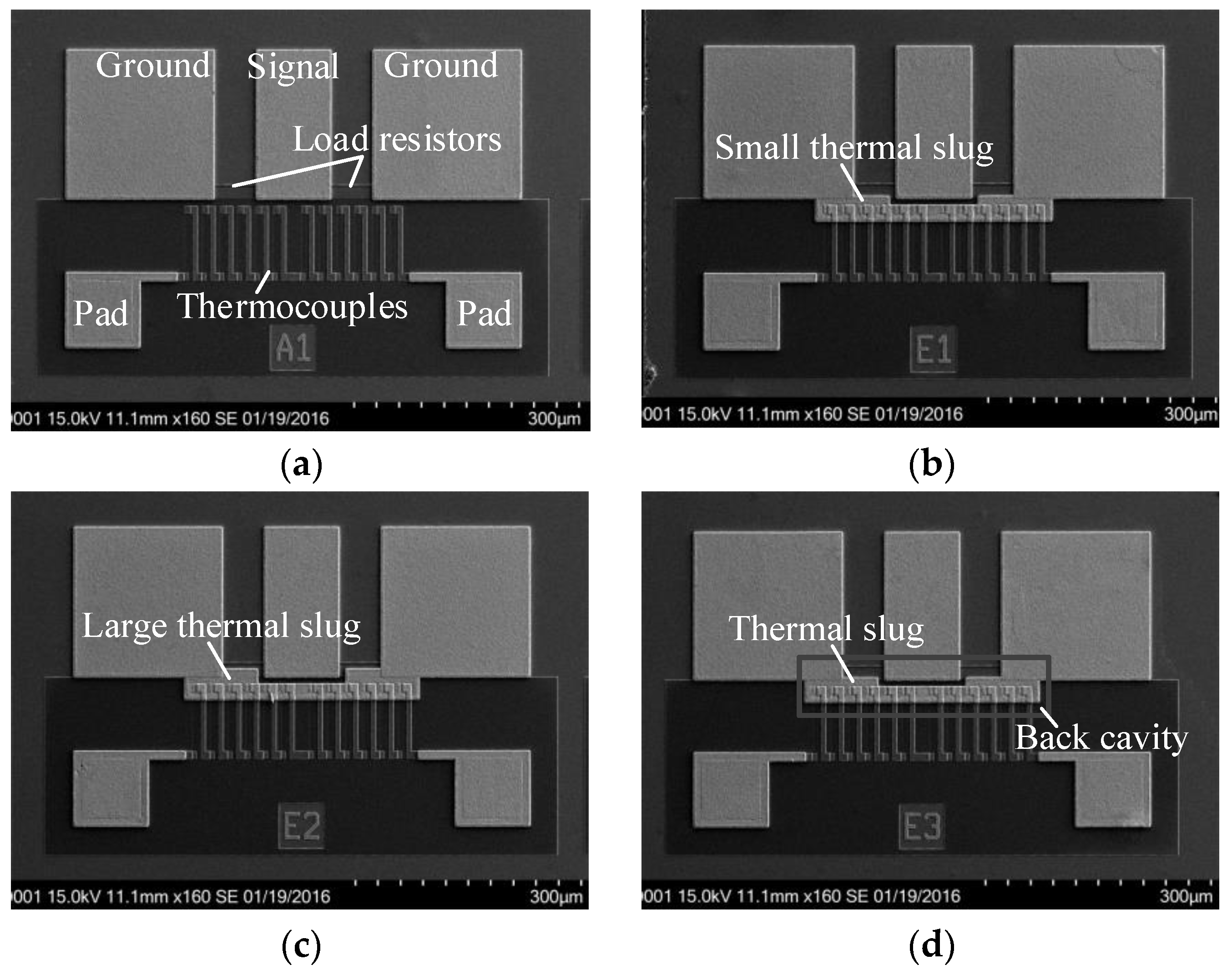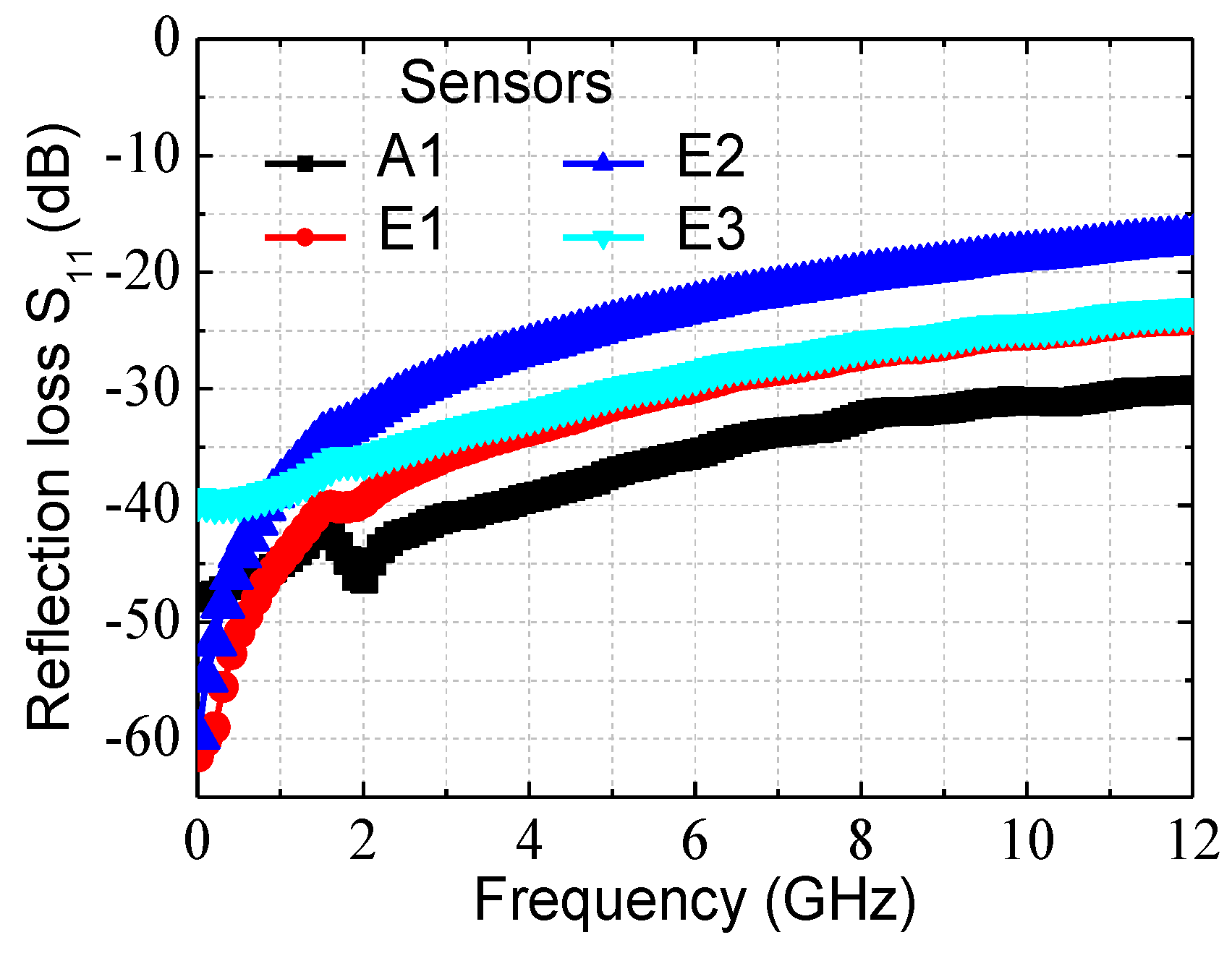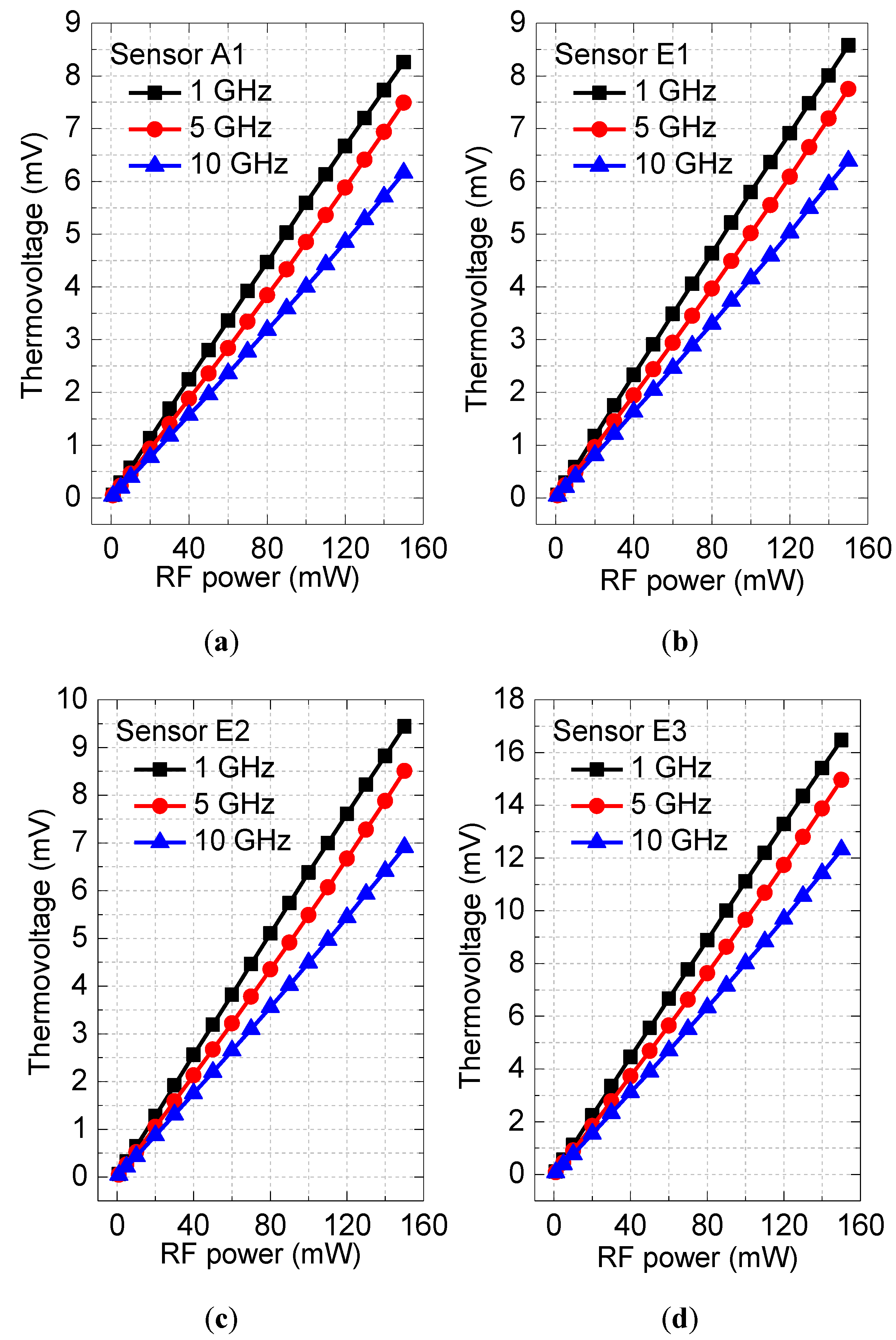n+ GaAs/AuGeNi-Au Thermocouple-Type RF MEMS Power Sensors Based on Dual Thermal Flow Paths in GaAs MMIC
Abstract
:1. Introduction
2. Principle and Design
3. Fabrication
4. Measurement and Analysis
5. Conclusions
Acknowledgments
Author Contributions
Conflicts of Interest
References
- Packard, H. Fundamentals of RF and microwave power measurement. Appl. Note 1978, AN 64-1. Available online: http://www.keysight.com/main/editorial.jspx?cc=SG&lc=eng&ckey=272209&nid=-34791.0.00&id=272209 (accessed on 16 June 2017).
- Brush, A.S. Measurement of microwave power—A review of techniques used for measurement of high-frequency RF power. IEEE Instrum. Meas. Mag. 2007, 10, 20–25. [Google Scholar] [CrossRef]
- Milanovic, V.; Gaitan, M.; Zaghloul, M.E. Micromachined thermocouple microwave detector by commercial CMOS fabrication. IEEE Microw. Theory 1998, 46, 550–553. [Google Scholar] [CrossRef]
- Milanovic, V.; Gaitan, M.; Bowen, E.D.; Tea, N.H.; Zaghloul, M.E. Thermoelectric power sensor for microwave applications by commercial CMOS fabrication. IEEE Electron Device Lett. 1997, 18, 450–452. [Google Scholar] [CrossRef]
- Dehe, A.; Krozer, V.; Chen, B.; Hartnagel, H.L. High-sensitivity microwave power sensor for GaAs-MMIC implementation. Electron. Lett. 1996, 32, 2149–2150. [Google Scholar] [CrossRef]
- Dehe, A.; Krozer, V.; Fricke, K.; Klingbeil, H.; Beilenhoff, K.; Hartnagel, H.L. Integrated microwave power sensor. Electron. Lett. 1995, 31, 2187–2188. [Google Scholar] [CrossRef]
- Wang, D.B.; Liao, X. Research on temperature characteristic of thermoelectric microwave power sensors based on GaAs MMIC technology. Electron. Lett. 2013, 49, 1462–1464. [Google Scholar] [CrossRef]
- Wang, D.B.; Liao, X.P.; Liu, T. Optimization of indirectly-heated type microwave power sensors based on GaAs micromachining. IEEE Sens. J. 2012, 12, 1349–1355. [Google Scholar] [CrossRef]
- Zhang, Z.; Liao, X. Packaging-test-fixture for in-line coupling RF MEMS power sensors. J. Microelectromech. Syst. 2011, 20, 1231–1233. [Google Scholar] [CrossRef]
- Yi, Z.; Liao, X. A 3D model of the thermoelectric microwave power sensor by MEMS technology. Sensors 2016, 16, 921–929. [Google Scholar] [CrossRef] [PubMed]
- Yi, Z.X.; Liao, X.P.; Wu, H. Modeling of the terminating-type power sensors fabricated by GaAs MMIC process. J. Micromech. Microeng. 2013, 23, 085003–085011. [Google Scholar] [CrossRef]
- Zhang, Z.; Liao, X. GaAs MMIC fabrication for the RF MEMS power sensor with both detection and non-detection states. Sens. Actuators A Phys. 2012, 188, 29–34. [Google Scholar] [CrossRef]
- Yi, Z.; Yan, H.; Yan, J.; Liao, X. Fabrication of the differential microwave power sensor by seesaw-type MEMS membrane. J. Microelectromech. Syst. 2016, 25, 582–584. [Google Scholar] [CrossRef]





| Sensors | Sensitivities (µV/mW) | ||
|---|---|---|---|
| 1 GHz | 5 GHz | 10 GHz | |
| A1 | 56.28 | 47.97 | 39.68 |
| E1 | 58.05 | 49.59 | 41.16 |
| E2 | 63.45 | 53.97 | 44.14 |
| E3 | 111.03 | 94.79 | 79.04 |
© 2017 by the authors. Licensee MDPI, Basel, Switzerland. This article is an open access article distributed under the terms and conditions of the Creative Commons Attribution (CC BY) license (http://creativecommons.org/licenses/by/4.0/).
Share and Cite
Zhang, Z.; Liao, X. n+ GaAs/AuGeNi-Au Thermocouple-Type RF MEMS Power Sensors Based on Dual Thermal Flow Paths in GaAs MMIC. Sensors 2017, 17, 1426. https://doi.org/10.3390/s17061426
Zhang Z, Liao X. n+ GaAs/AuGeNi-Au Thermocouple-Type RF MEMS Power Sensors Based on Dual Thermal Flow Paths in GaAs MMIC. Sensors. 2017; 17(6):1426. https://doi.org/10.3390/s17061426
Chicago/Turabian StyleZhang, Zhiqiang, and Xiaoping Liao. 2017. "n+ GaAs/AuGeNi-Au Thermocouple-Type RF MEMS Power Sensors Based on Dual Thermal Flow Paths in GaAs MMIC" Sensors 17, no. 6: 1426. https://doi.org/10.3390/s17061426




